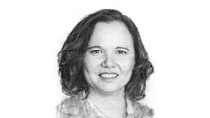Palo Alto–based Hewlett Packard Enterprise focuses on the IT needs of businesses, governments, and other organizations large and small. Now independent from the printing and personal-system business that today is known as HP Inc., Hewlett Packard Enterprise’s 240,000 employees generated more than $50 billion in revenue in fiscal year 2015.
The company is currently in the midst of transforming itself, reflecting the IT industry’s evolution from selling standardized hardware and software for clients to own to providing more flexible, hybrid solutions. For the sales organization, the changes have meant developing new capabilities to meet clients’ more-sophisticated needs, and more capacity to serve clients of all sizes more effectively.
These demands have led to a reexamination of traditional B2B sales models, which have long tended to focus more on the field-sales forces working face to face with fewer, larger clients than on the inside-sales specialists who work with many small and medium-size clients through phone, online, email, or other remote channels. Alice Coatalem, Hewlett Packard Enterprise’s vice president for inside sales for the Europe, Middle East, and Africa (EMEA) region, has led a new approach to turn inside sales into a real engine for growth. She spoke with McKinsey’s Raffaella Bianchi and Christian Johnson from her office in Paris.
McKinsey: What opportunities did you see in the company’s inside-sales organization and the broader market?
Alice Coatalem: We started our deep review of our inside-sales organization about three years ago. At that time, the general model was that each country had its own inside-sales team, which operated mainly as a support function to the field-sales force rather than as another sales channel. The theory was that all sales-related people, whatever role they played in the sales organization, should be physically close to their clients.
Three developments led us to question our approach. The first was the high level of fragmentation it produced: the roles that individual inside-sales representatives (ISRs) played and the practices that the teams followed turned out to be highly inconsistent across our locations. Although there were definite pockets of excellence that we thought we could replicate, it was difficult just to compare the service model across the organization or measure inside sales’ contributions accurately.
Second, clients were telling us that in a digital world, they wanted the easy availability of communicating with their sales teams via remote channels. In-person relationships would still matter, of course, but a quick answer would often matter more. And third, we recognized there were always going to be limitations on how many clients we could serve well with a mainly field-based model, largely because of the time it takes to meet people in person across a large territory.
We therefore needed to find the right balance, taking into account the clients’ expectations, the channel-service model, and the coverage opportunity.
McKinsey: How could inside sales help?
Alice Coatalem: Freed of the logistical demands that a field force must meet, an inside-sales organization can provide a proactive, highly accessible form of contact with clients. And because the clients that an inside-sales team serves are often smaller, it takes less time to get to know their business challenges and form real relationships.
These factors all pointed toward a way to transform inside sales into its own consolidated organization, targeting strong go-to-market capabilities toward small and medium business companies that the field force would not be able to serve well. But this new model would require greater consistency and therefore greater scale—and a more structured and centralized organization.
McKinsey: What structural changes did you have to make to transform the inside-sales organization?
Alice Coatalem: Instead of each country overseeing its own inside-sales team—sometimes quite small—we created an EMEA-wide consolidated organization with its own budget and people. That allowed us to strengthen our focus on consistent execution. To get a good mix of language coverage, skill availability, scale, and cost structure, we decided to locate this organization in three consolidated, multilingual hubs that would be able to serve our clients in their native languages.
Our new model relies to a large extent on hiring young, multinational candidates—typically business-school graduates—into ISR positions. We train them ourselves, assign them their own sales targets and lists of accounts, and evaluate them based on all of the usual metrics one would expect from a field-sales force—how they manage their sales pipelines, how deep their customer relationships are, and so forth. Their career progress is then tracked through a set of highly visible milestones.
McKinsey: What did it take to persuade the countries to let go of their inside-sales teams and rely instead on ones in remote locations?
Alice Coatalem: Some of the countries were quite skeptical at first. The most difficult questions concerned how the collaboration would work: who would be responsible for which accounts, how ownership for particular sales would be allocated, and so forth. Once we resolved those issues, we also had to work on the mind-sets of the field-sales teams in the country-level organizations as they transitioned. They were used to being able to set expectations for the inside-sales force on almost an individual basis—now these needed to become more standardized.
Our strategy was to move faster with the countries that felt more of a need for help, perhaps because they had fewer resources in their local organization or were having trouble meeting existing demand. We invested more time and thought in those areas. Once country managers saw their pipelines filled with more opportunities than they were aware of previously, it became very easy to convince them to invest more in this new model.
Now the country managers really enjoy working with this young and talented workforce—so much so that it seems as though everybody wants more ISRs to work with them and increase their market coverage.
McKinsey: The career pathway sounds especially crucial.
Alice Coatalem: Yes. We made a commitment to the ISRs that after a minimum of two years in the hubs, they would have an opportunity to advance in their careers, either in the hubs or in their home countries. That’s how we are able to attract high-potential candidates into these roles while keeping turnover low.
After two and a half years of existence, the inside-sales organization is becoming a very visible talent pool for the entire EMEA organization. A number of ISRs who joined us as fresh graduates have now moved on, mainly into junior field-sales positions in their home countries. Two of them immediately became territory managers, which is a major promotion. Others are now account managers in global account teams or have moved into functional roles in areas such as strategy and planning or marketing. And a few have advanced into supervisor, team leader, or manager roles in the hubs.
McKinsey: What were the top factors that you considered in deciding where to locate the hubs?
Alice Coatalem: First, we had to determine the hubs’ size. Critical mass is really important, not only to the economics of a hub but also for the momentum and energy it builds. Our estimate was that each hub should host at least 200 people. For the whole inside-sales organization, our initial target was for about 600 people. That meant a maximum of three hubs.
We decided to go for three instead of one or two because we wanted to be able to offer locations that fit with the diversity of the countries we cover, from Ireland to Russia to South Africa. And we wanted locations where we felt we could attract an international workforce of young, talented native speakers who are aspiring to a sales or business career and are motivated for a career abroad.
McKinsey: How much of the old organization converted to this new model?
Alice Coatalem: We were fortunate: a few of the experienced people in the old country-level organizations were willing to move into leadership or senior-expert roles at the new hubs. Most of the rest used their track records to transfer into other roles within the company.
McKinsey: What does the client experience today, compared with three years ago?
Alice Coatalem: This model has allowed us to replicate much of the experience that our field-sales team gives our larger clients—but over the phone and the Internet. Each of our inside-sales clients has a single ISR serving them. Because we are better able to balance workloads at our centers, our ISRs have more time to reach out and talk to their clients than in the past. That creates more opportunities to understand the client’s business challenges and IT requirements and propose real solutions. The clients are able to reach the ISRs more easily as well.
McKinsey: How would the country organizations describe the difference?
Alice Coatalem: Their management burdens are lower, because inside sales is overseen entirely from the hubs and the EMEA organization. The countries don’t need to worry about daily people management, training, or career development—they just have additional people who they know can work with their clients. That lets the country organizations focus on their own expertise: helping our ISRs understand the local client base, making introductions, and supporting ISRs in identifying and completing potential sales to those clients.
McKinsey: When did you sense that this new approach was finally starting to work?
Alice Coatalem: We have a program that celebrates major inside-sales victories, such as winning a competitive account or making a major technology breakthrough with a client. I knew the model was working the first time I saw deals listed there—deals that we initially assumed were out of scope for inside sales because of the complexity of the solution and the competitiveness of the market. One of them was a high-performance computing deal with a client that needed a cutting-edge solution. The ISR coordinated a range of expertise that would not have been available under the old country-level structure.
That reflects a real shift in what the ISRs are doing. It isn’t only about commodity infrastructure; they’re really selling solutions. The solutions are at a smaller scale than with our field-sales force, but they are still solutions tailored to specific customer needs.

Are you really listening to what your customers are saying?
McKinsey: What business results are you seeing?
Alice Coatalem: The first metric we saw improve was the share of the “addressable market” that we can now cover; I can’t disclose specific figures, but it has risen substantially. The coverage of each client—how often we speak with them, for example—is also greater. And the pipeline of projects has grown, including not only the small and midsize projects that we cover but also the large projects that we hand over to our field-sales colleagues. As a result, several client segments are showing significant sales growth.
McKinsey: How are your costs compared with the old model?
Alice Coatalem: We did this all within the same basic cost envelope. During the transition, we committed to stay within the previous structure’s budget even though we incurred all of the costs of the transformation. Since then our budget has increased, but only in proportion to our head-count growth—which has been in response to demand from the countries and is quite a lot smaller than our sales growth.
McKinsey: What would you do differently if you were to start today?
Alice Coatalem: One of the surprises was in hiring internationally for the three centers. Of course we had planned to adapt our hiring to the local conditions of the three centers, but we underestimated just how much we would also have to adapt our recruiting to the countries we were recruiting from. For example, in order to hire enough German speakers at our Central European center, we had to rethink our recruiting approach according to the competitive situations in each of the German-speaking countries. That cost us some time.
The other major challenge is in adapting to our client’s high demand for solutions, rather than transactional, specification-based hardware sales.
To craft solutions, ISRs need deep technical support. We initially had planned to rely on country-level personnel, but we found that the results were better when ISRs could get presales technical support right in their hub—specialists who could help engage clients over the phone to explain the technological benefits of a proposed solution or understand particular technical concerns. We are now working to close that gap.
McKinsey: If you were to advise someone thinking about the opportunities in their inside-sales organizations, which success factors would you identify as the most important?
Alice Coatalem: In my experience, the processes, mind-sets, training, and marketing for inside sales are all different from field sales, and the only way for inside sales to get the resources it needs to be successful is to create its own functional organization. Consequently, I’d say that the initial decision to create a truly centralized inside-sales function, reporting at a high level to the larger sales organization, was essential.
The second crucial factor is leadership: this type of change needs leaders who have deep sales experience and are committed to inside-sales progress. Speaking from experience, strong top-down support is also instrumental for such a huge transformation—and therefore it also helps to have good relationships with stakeholders throughout the sales organization. We needed all of the help they were able to give.
The final point is replication. We designed a blueprint for the first hub organization and followed it for the other two. Of course, each hub has a bit of its own identity based on the local culture and the chemistry between the local leader and the team. But the way all three hubs operate is exactly the same—the processes, the terminology, the tools, everything.
McKinsey: What are the next big problems you want to tackle?
Alice Coatalem: I see three. The first concerns scaling. We have grown a bit, and our model now works well with about 700 people. We still have a lot of room to expand: supporting more clients, more countries, a greater share of the business. We need to decide how best to accommodate that growth. Second, we need to make sure that we can meet our commitments to our people and absorb our young talent elsewhere in the organization as they progress in their careers. Third, the demand for advanced expert support in the hubs will only grow. It’s a good problem to have, but it does mean finding more people with specialized skills.



